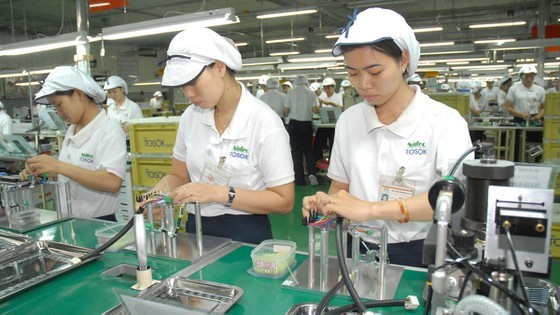
Enterprises not only want to develop market share in Vietnam but also to invest in the country so as to make use of trade advantages that Vietnam is enjoying.
Attraction from export turnover
According to the ministry, by November this year, there were 30 export products with export turnover of above US$1 billion, accounting for 91.6 percent of total exports, mainly focusing on key product lines, including electrics, electronics, garment and textile, footwear, plastics, computers and components.
Specially, there were five products with export turnover of above $10 billion, accounting for 59.6 percent. Particularly, cellphones and components had the highest export value of $48.7 billion, accounting for 20.2 percent of total exports, an increase of 5.4 percent over the same period last year. Electronics, computers and components reached export turnover of $32.4 billion, an increase of 19.4 percent. Exports of garment and textile touched $29.9 billion, an increase of 7.8 percent. Footwear exports hit $16.5 billion, an increase of 12.5 percent. Machineries, equipment, tools and spare parts got $16.5 billion in export turnover, an increase of 9.8 percent.
On the contrary, export turnover of several agricultural products continued to decline compared to the same period last year. Particularly, aquatic product exports reached $7.8 billion, a decrease of 2.3 percent; export turnover of vegetables and fruits was at $3.4 billion, a decrease of 2.4 percent; cashew nut exports were at $3 billion, a decrease of 3.4 percent; rice exports touched $2.6 billion, a decrease of 8.3 percent; coffee exports were at $2.5 billion, a decrease of 22.2 percent; and pepper exports were at $672 million, a decrease of 6.5 percent. Meanwhile, export turnover of rubber reached $2 billion, an increase of 7.6 percent and export turnover of tea touched $212 million, an increase of 8.2 percent.
As for export markets, in the first 11 months of this year, the US continued the largest export market of Vietnam with export turnover of $55.6 billion, up 27.9 percent. Exports to the ASEAN market reached $23.4 billion, up 2.4 percent; to Japan’s market hit $18.6 billion, up 7.6 percent; to South Korea touched $18.4 billion, up 10.1 percent over the same period last year. Although the European market and Chinese market still got high export turnover, however, in comparison with the same period last year, export turnover to the EU was at $38 billion and to China was at $37.4 billion, down 2.3 percent and 0.6 percent respectively.
According to the General Statistics Office of Vietnam, total import-export turnover in the first 11 months of this year was estimated at $473.73 billion, of which, exports hit $241.42 billion, up 7.8 percent over the same period last year.
Ms. Ly Kim Chi, chairwoman of the Food and Foodstuff Association of Ho Chi Minh City, said that although Vietnam has signed several free trade agreements, enterprises have not taken advantage of these FTAs well. Production capacity of several domestic enterprises is still weak, failing to meet new technical barriers set by many markets in the world.
At the present, the ministry has been collaborating with relevant departments, provinces and associations to organize several activities to help enterprises to approach regulations of FTAs. Thereby, enterprises will have investment strategy to make use of advantages when exporting to markets that Vietnam has signed FTA with.
Investment opportunities
However, from another perspective, this is an opportunity for foreign enterprises to participate in investing and exploiting export market as well as domestic market in Vietnam. Representative of Korean business delegation said that Korean enterprises participated in the event held by the ministry are in the fields of electronics, electrics, educational equipment, cosmetics and beauty equipment, food, processed drinks and health-care food. These are products that Korean enterprises have understood the market and determined customer segmentation in Vietnam’s market as well as export.
In fact, export turnover of electrical and electronic products, computers and components in Vietnam has continuously maintained growth of above 20 percent in the past five years. Economic experts also assured that that growth level will continue to be kept for at least the next ten years. Meanwhile, in domestic market, population size of Vietnam continues to increase rapidly, estimating to touch 130 million people in the next five years. Especially, more than 60 percent of Vietnamese population is young population with fast access to electrical, electronic and information technology devices. This is a golden opportunity for enterprises to invest in this potential market.
Meanwhile, Indonesian business delegation chooses high-quality products, such as packed food, over-the-counter pharmaceuticals, especially, skin-care products made from natural ingredients of Indonesia, to seek for partner to develop in Vietnamese market. Indonesian enterprises think that the demand for cosmetics and beauty products of Vietnamese people is extremely high. Meanwhile, domestic cosmetic market merely meets 5 percent of domestic demand. Therefore, investing in this segment will help Indonesian enterprises to enter deeply into Vietnamese market.
Obviously, when assessing the potential of Vietnamese market, several enterprises always affirm that made-in-Vietnam products are having many advantages to expand market. In addition, preferential policies to attract investment of Vietnam along with advantages from investment environments, such as stable politic situation, skilled labors, fast-growing proportion of domestic material supply. Especially, diversity in material source of agro-aquatic products has created certain favorable conditions for foreign enterprises to increase their presence in Vietnam in the future, especially manufacturing and processing enterprises.
























